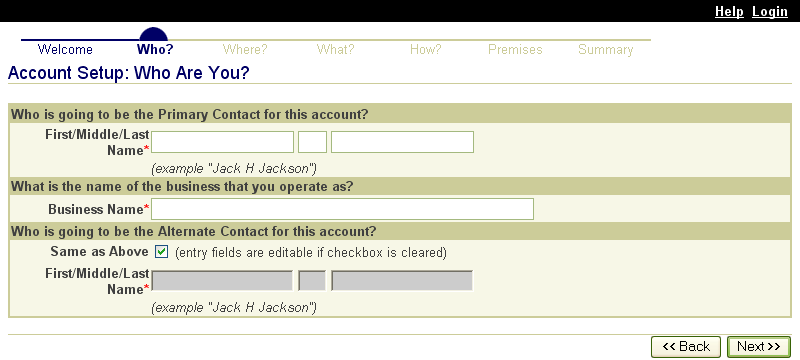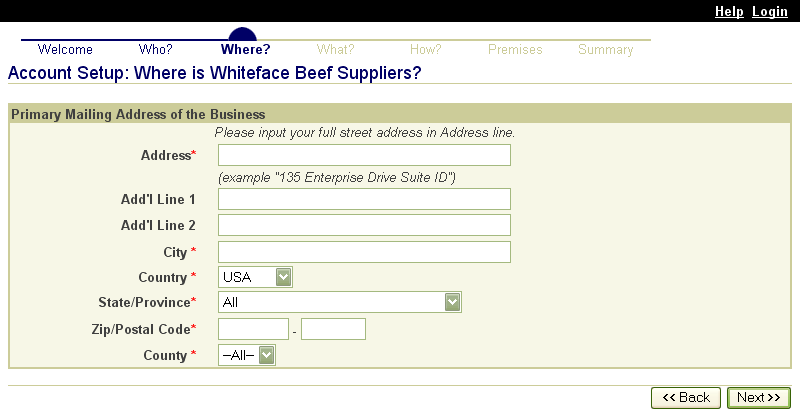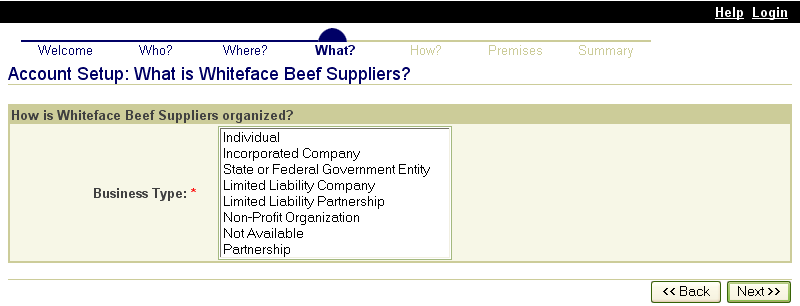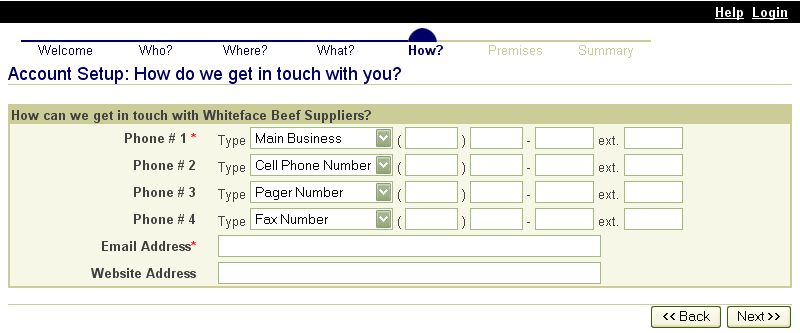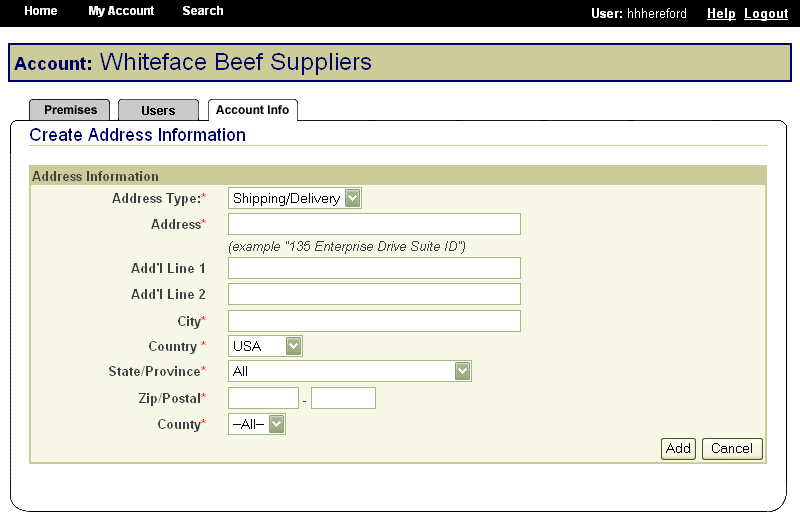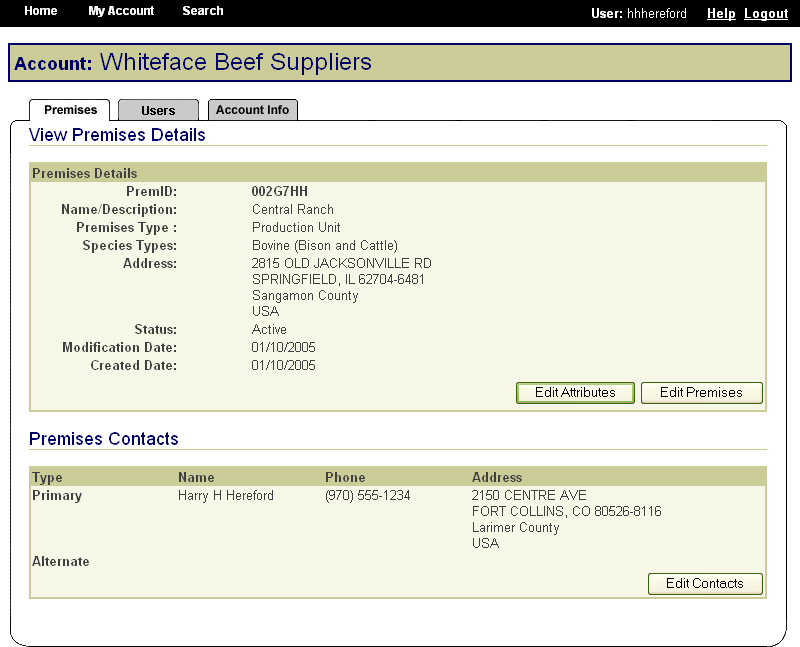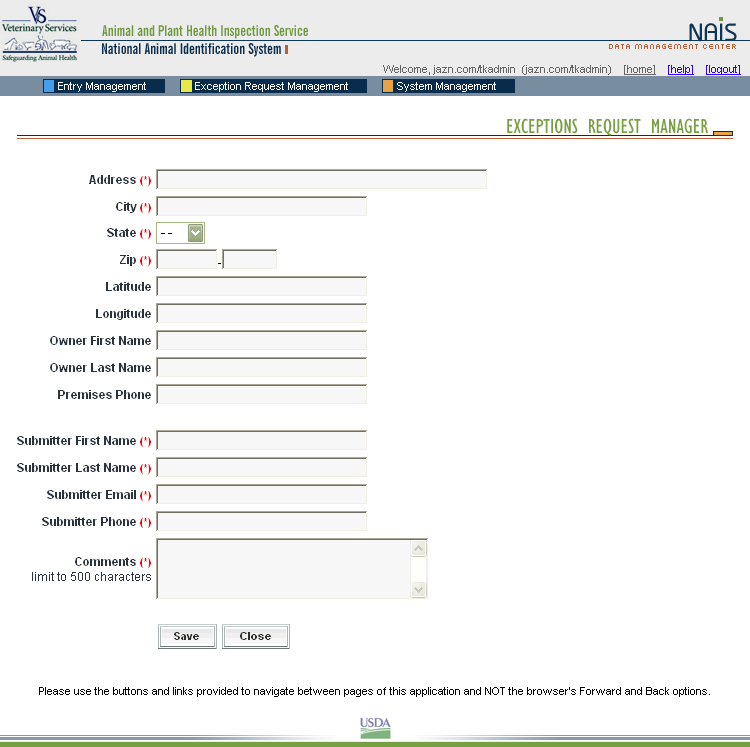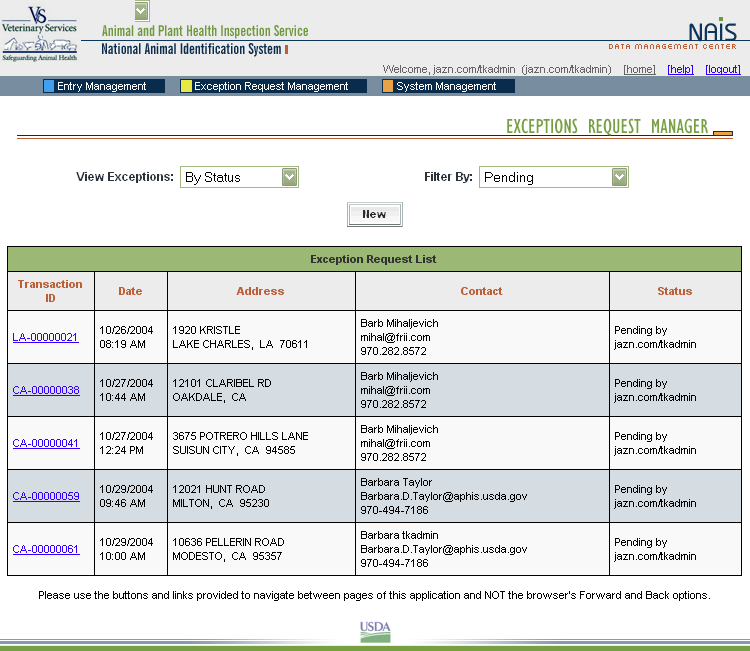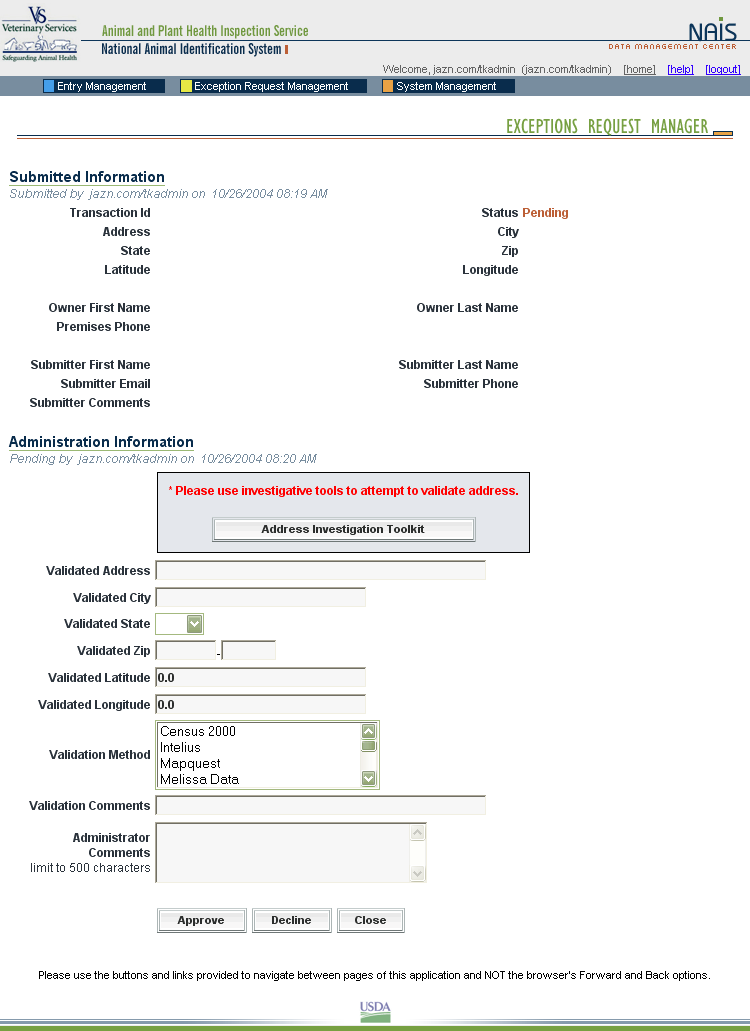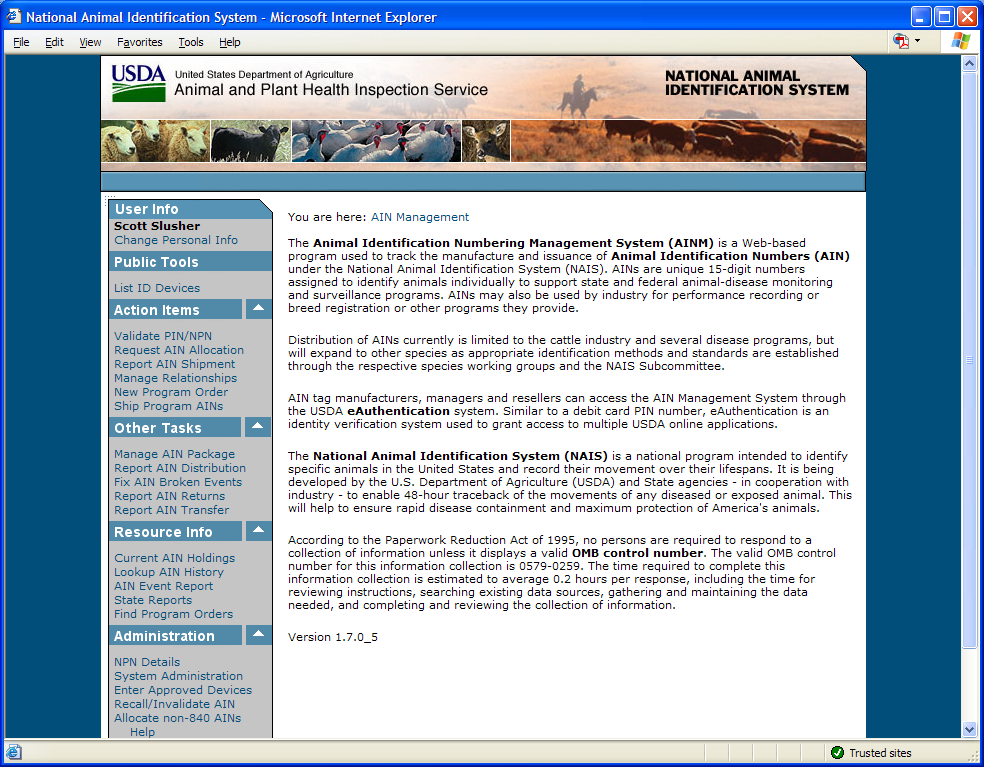SS revised 12-15-09
SS revised 12-15-09.doc
National Animal Identification System
OMB: 0579-0259
SUPPORTING STATEMENT 0579-0259
NATIONAL ANIMAL IDENTIFICATION SYSTEM
November 2008
Development of the three components of the National Animal Identification System (NAIS) – premises registration, animal identification, and animal tracing – has been incremental since June 2004, with each component building on the one before. In order to ensure the most practical and efficient system evolves, the U.S. Department of Agriculture (USDA) has been soliciting
stakeholder and participant feedback to help shape the system. Although the original
information collection request (0579-0259) broadly covered each component of the system, over the course of the NAIS’ development during the past 3 years, specific information collection needs arose when new forms became necessary to allow participation in the animal identification and animal tracing components, as those components became more fully developed. As a result, the Animal and Plant Health Inspection Service (APHIS) received Office of Management and Budget (OMB) clearance on three additional information collections for the NAIS that it would like to fold into the original number (0579-0259), to streamline the process for future renewal requests. Specifically, APHIS would like to include 0579-0283 and 0589-0288 as part of
0579-0259. Number 0579-0283 covers the forms necessary for participants in the animal
identification component as animal identification number (AIN) device manufacturers,
managers, or resellers. Number 0579-0288 covers the information necessary for interested
organizations to request evaluation of their animal tracking databases (ATDs), as well as the
cooperative agreements they sign if their systems are compliant with NAIS needs. APHIS
expects these activities to continue, as the animal tracing component becomes finalized and the animal identification component increases. Information about these activities is provided in the following sections.
A. Justification
Explain the circumstances that make the collection of information necessary.
Identify any legal or administrative requirements that necessitate the collection.
Attach a copy of the appropriate section of each statute and regulation mandating or authorizing the collection of information.
Since June 2004, USDA has been developing and implementing the NAIS. The NAIS is a
voluntary, cooperative Federal-State-industry partnership with three components: premises
registration, animal identification, and animal tracing. The NAIS is a modern, streamlined
information system that helps producers and animal health officials respond quickly and
effectively to animal disease events in the United States. The program is essential in helping animal health officials protect U.S. livestock and poultry from disease spread, and retain access to domestic and foreign markets. Timely response to disease outbreaks will result in: (1) less disease spread and reduced economic impact; (2) less disruption to producers/animal owners;
(3) quarantine and/or movement restrictions lifted in a more timely manner; (4) possibility of fewer animal euthanized; and (5) increased consumer confidence.
Fundamental to controlling any animal disease threat, foreign or domestic, is to have a system that can identify individual animals or groups, the premises where they are located, and the date of entry to each premises. Further, in order to achieve optimal success in controlling or
eradicating an animal health threat, the timely retrieval of this information and implementation of intervention strategies after confirmation of a disease outbreak is necessary. The basic data
acquired through the NAIS components will support the objective of achieving timely animal tracebacks and trace forwards when responding to an animal disease concern.
The long-term goal for the NAIS is to create an effective, uniform, consistent, and efficient
national system that can achieve a successful traceback within 48 hours. The Animal Health Protection Act (7 U.S.C. 8301 et seq.) provides the legal authority for this program in order to ensure the health and economic well-being of U.S. livestock.
Premises Registration
USDA has made a great deal of progress with the three components of the NAIS in the past 3 years. To begin with, to track animals, we must know where they are born and where they are moved. Identifying locations that manage or hold animals—referred to as premises—is the
starting point of the NAIS. Each premises that participates in the NAIS is identified with a unique seven-character identifier, which is recognized as a premises identification number (PIN). Having the ability to plot locations within a radius of an infected premises helps determine the potential magnitude of contagious disease and the resources that are needed to contain it. This can only be done if the infected premises and other premises in the area are registered prior to the outbreak. The availability of nationwide premises registration data saves manpower, time, and logistical support. Since August 2005, all 50 States, 2 Territories, and several Tribes have been participating in the premises registration component of the program, using either the
standardized premises registration system (SPRS) provided by USDA or a USDA-approved compliant premises registration system (CPRS).
Animal Identification
Animals participating in the NAIS are identified either individually with a unique AIN or, if they are managed and moved through the production chain as a group, with a Group/Lot
Identification Number (GIN). Animal identification associates an animal with a premises ID and will provide the origin, or birthplace, of the animal. The initial implementation of the animal identification component began in 2006 and has been focused on livestock that utilize visual identification tags (e.g., cattle). Performance requirements are also now available for
identification devices for swine and equines. The use of the AIN with other types of
identification devices (e.g., implants) for other species are also being considered as the NAIS species working groups finalize their recommendations. APHIS is currently evaluating and
approving identification devices and technologies and allocating AINs to approved device
manufacturers through the AIN Management System, which is a Web-based computer program that provides the means to record AIN allocations and distribution of devices. Approved device manufacturers provide devices to producers or to AIN managers and/or resellers who distribute AIN devices to producers. USDA has approved eight identification devices from five companies for use in the NAIS. Seven eartags and one injectable transponder use International
Organization for Standardization (ISO)-compliant radio frequency identification (RFID) technology. The AIN Management System, deployed in March 2006, supports the administration of all AIN devices.
Animal Tracing
As animals move from one premises to another, a few basic pieces of information will be
reported to privately-held animal tracking databases that State and Federal animal health officials can request information from in the event of an animal disease incident. As animals move from premises to premises, the AIN or GIN will be associated with the new PIN while the animals maintain their original numbers.
USDA developed a single portal, referred to as the Animal Trace Processing System (ATPS) to allow authorized State and Federal animal health officials to request information from the administrators of the ATDs in certain situations:
An indication (suspect, presumptive positive, etc.) or confirmed positive test of a
foreign animal disease.
An animal disease emergency as determined by the Secretary of Agriculture and/or State Departments of Agriculture.
The need to conduct a traceback or trace forward to determine the origin of infection for a program disease (brucellosis, tuberculosis, etc.).
The ATPS, which provides security access and auditing functions, is now operational at the
Federal level. USDA deployed the ATPS in our IT environment on March 17, 2007. Working with States and industry, USDA developed the technical requirements necessary for integration of private/State ATDs with USDA’s ATPS. USDA published a guidance document with these requirements in February, which is available on the NAIS Web site: (http://animalid.aphis.usda.gov/nais/naislibrary/documents/guidelines/ATPS_Technical_Specs.pdf). As with the interim phase, interested organizations request evaluation of their systems and sign formal cooperative agreements with USDA if their systems meet those technical
specifications. Several ATDs are now fully functional and integrated with the ATPS. As more ATDs come on-line, and as the volume of animal movement records increases, animal health
officials will have more and more data available through the ATPS and its established
communication infrastructure with the ATDs.
Successful implementation of the NAIS will depend on the effective use of three primary
information collection activities: premises registration and nonproducer participant
identification records, individual animal identification transaction records, and group/lot
transaction records that will be created and maintained through various industry, State, Tribe, Territory, and Federal collaborative efforts. While limited premises and animal identification data will be submitted to and used at the Federal level, most premises and animal identification information, and all animal tracing data, will be held at the State or Tribal level or in private databases. As noted earlier, State and Federal animal health officials will request information about animal movements only in response to animal disease events. Some records (such as premises registration records) will be modified on occasion, while animal data records will be updated more frequently.
For instance, premises data will be entered only when events warrant, such as when a premises (1) is created, (2) ceases operation, or (3) changes ownership. Updates of information on
reportable animal movements will occur more frequently, such as (1) when an animal is bought, (2) sold, or (3) otherwise moved from one premises to another; or (4) when a group of animals is moved. More specific guidelines for which types of movement should be reported, specific to individual species, are being developed by the Species Working Groups and will be finalized when the animal tracing component is fully operational and when animal identification methods and devices have been finalized and are available for each species.
This system for identifying and tracing individual animals and animal groups will not constitute an additional animal identification burden for animals in which identification is required, but simply replace or supplement various systems currently being used. In many cases, it will
reduce the animal identification, since NAIS-compliant devices are official for use in all existing animal health programs.
Cooperative Agreements
Development and implementation of the NAIS continues to be a partnership between USDA, the States, Tribes, and industry. States and Tribes enter into cooperative agreements with USDA to implement the premises registration and animal identification components; some States with animal tracking databases have also entered into cooperative agreements to participate in animal tracing. Industry has been entering into cooperative agreements with USDA to promote
premises registration through outreach/education to producers and livestock groups. Finally,
organizations interested in promoting outreach/education activities to promote the NAIS to
under-represented groups can also apply for cooperative agreement funds. For all agreements, interested entities complete and submit to USDA an application for funding that includes an overview of proposed activities. Agreements will continue to be necessary as USDA moves forward with development and implementation of this cooperative program.
Because APHIS’ NAIS is voluntary and continues to evolve, APHIS anticipates that
participation levels will continue to grow as the animal identification and animal tracing
components become more established. OMB, however, approves information collection requests in 3-year increments only. The burden estimates APHIS has developed, therefore, represent only those hours likely to be generated by this program over the course of the next 3 years.
APHIS believes this is the most accurate way—at this stage of a complex and evolving
program—to represent the burden hours likely to be experienced by the regulated public during the next 3 years. These estimates, of course, must be regarded as highly fluid, since it is difficult to predict the pace at which producers and animal owners will elect to participate in the NAIS nationwide.
APHIS is asking OMB to extend approval, for 3 years, of its use of these information collection activities in connection with its efforts to carry out the NAIS.
Indicate how, by whom, how frequently, and for what purpose the information is to be used. Except for a new collection, indicate the actual use the agency has made of the information received from the current collection.
The NAIS is being developed as an information system and infrastructure to support USDA’s long-term 48-hour traceback objective. The overall system supports the identification of each premises, as well as each Nonproducer Participant; and the recording of AINs, GINs and other official identification methods Additionally, the system must associate or link the animal identification data to each premises where the animal or group was located and the specific dates the animals were at each location.
Premises Registration
The premises registration system (databases) provides for the administration of premises
enrollments according to the national requirements. The States and Tribes administer the
enrollment of premises within their geographic areas (or boundary of the multiple States working together). APHIS has provided the SPRS information system that a State or Tribe may elect to use. Forty-one States, 7 Tribes, and 2 Territories currently use the SPRS, which is available through the internet. APHIS is responsible for its development, enhancement, maintenance, and operation.
States and Tribes may also choose to use a CPRS, which are either State systems or third party systems evaluated and determined to be compliant with NAIS data standards. The CPRS are also available online and operate the same way the SPRS does; however, development,
enhancement, maintenance, and operation of these systems is the responsibility of the States or third party who administer the systems.
Because premises registration is the foundation of the NAIS, APHIS encourages all producers to register their premises. States and Tribes register those premises in their respective geographic areas. Minimal premises information is then forwarded automatically by the information
systems to the national repository. Premises owners/operators supply the necessary information to the States or Tribes using the communication method most convenient to them—whether through the internet, by hard copy, fax, e-mail message, or telephone call. Alternately, the
premises owner/operator can register themselves online, through the State Website. After the registration process is complete, the premises information contained in the database is updated if premises go out of business, come into existence, change ownership, or experience any other noteworthy changes to their operations that should be recorded in the database.
Updates to Premises Registration
Registration and update information must include the PIN, the name of the entity, the owner or appropriate contact person, a contact phone number, the premises address, the date the operation was activated, the date the operation changed ownership or ceased operations, the reason for this event, and the names and phone numbers of previous contact persons.
This data is automatically maintained for 20 years at the State level in the premises registration databases. This will provide animal health officials with the proper contact reference in those instances when the current contact person was not associated with the premises during the period being researched in a traceback situation.
Contact information provided during premises registration opens the lines of communication
between producers and animal health officials—which is critical in preventing the spread of
disease. State animal health officials can query their respective databases to determine what
locations are in a general area during a disease outbreak or incident and can then use the contact information to inform producers and animal owners about potential disease exposure and steps they should take to protect their animals. Although it is impossible to predict how many disease traceback investigations, or emergency responses (e.g., responding to natural disasters such as the blizzard in Colorado in early 2007), or disease outbreaks (e.g., recurring West Nile virus
incidents in Wisconsin) might occur in the next 3 years that would necessitate State animal health officials accessing premises registration information, these occasions are relatively
infrequent and localized.
Nonproducer Participant Registration
In addition to the premises registration, the NAIS provides for the registration of entities that do not hold or manage livestock, but are otherwise involved with the food animal industry and could therefore become a vital investigative link during an emergency traceback scenario. These are called Nonproducer Participants, and include such entities as State animal health officials,
accredited veterinarians, AIN Managers/Resellers (individuals or firms responsible for assigning AIN devices to producers), AIN Device Manufacturers (companies that manufactures AIN
devices), third party service providers (companies that provide herd management, dairy herd
improvement, genetic evaluation, and other services), veterinary clinics, and diagnostic
laboratories and livestock buyers/dealers who submit data to the national database.
AIN Device Manufacturer Applications, Agreements, and Training
(This includes Transitional AINs, Visual Only Eartags, RFID Eartags, and RFID Injectable Transponders)
AIN Device Manufacturers are companies authorized by APHIS, through an AIN Manufacturer Agreement signed with APHIS, to manufacture approved identification devices and are responsible for the overall production and quality of the official identification devices that contain the AIN. The AIN Device Manufacturer may only produce AIN devices with the AINs that have been allocated to them by APHIS. AIN Device Manufacturers may also be Device Managers.
AIN Device Manufacturers must:
Complete the AIN Device Manufacturer application;
Abide by the terms and conditions set forth in the AIN Manufacturer agreement;
Complete the AIN Device Manufacturer training program provided by USDA;
Imprint the “840” AINs allocated to them with the U.S. Shield on identification devices
approved by APHIS;
Maintain the uniqueness of the AINs allocated to them;
Imprint approved devices according to the specifications listed in the NAIS Program
Standards document (available on the NAIS Web site at: http://animalid.aphis.usda.gov/nais/naislibrary/documents/guidelines/Program_Standard_and Technical_Reference.pdf);
Report the shipment of all AIN devices to the AIN Management System according to
established protocols within 24 hours of shipment;
Have an operational computerized system that communicates with the AIN Management System and is compatible with NAIS standards to maintain the necessary information,
including a database of the manufacturer product code for all devices that contain an AIN;
Have a means to support the distribution of AIN devices through established relationships with AIN Device Managers or being an AIN Device Manager themselves;
Agree to discontinue the printing of any identification numbering system as prescribed by USDA if the numbering system is terminated and phased-out as an official numbering system by USDA;
Maintain an ongoing list of current inventory of AIN devices and have that list available to the USDA upon their request (Note: this list does not require additional recordkeeping; the Manufacturer must simply agree that USDA has the right to review the current inventory of AIN devices at any time); and
Enter the names of Nonproducer Participants that they wish to utilize as AIN Device
Managers into the AIN Management System advising them that such designation requires participation in AIN Device Manager training provided by USDA.
APHIS provides device manufacturer applications, which can be requested through the Website (http://animalid.aphis.usda.gov/nais/animal_id/index.shtml) or by contacting NAIS staff directly via email or phone for several different devices, including visual-only eartags, RFID eartags, and RFID injectable tranponders. Device manufacturers provide information about their devices, which APHIS uses to determine whether or not to approve the company’s or entity’s device as an official device for use in the NAIS. In keeping with USDA’s technology neutral position,
additional types of devices might also be approved for use in the future, based on
recommendations from the Species Working Groups.
Updates and Recordkeeping
After registering to obtain a Nonproducer Participant Number (NPN), these entities will
continuously provide updated information regarding their status as the need arises. Nonproducer Participants who register with the NAIS and who submit information to the AIN Management System routinely maintain certain records associated with their animal identification activities for a period of 2 to 5 years. This recordkeeping is standard business procedure, and is often
required by Federal regulations if the entity or individual is involved in other USDA programs. This information is maintained because it could provide critical information during a disease
traceback.
AIN Device Managers Registration and Agreement/Training
AIN Device Managers are individuals, organizations, or companies that provide AIN devices to another AIN Device Manager, Reseller or directly to a premises. The AIN Device Manager must have an established relationship with an AIN Device Manufacturer(s).
In order to be an authorized AIN Device Manager, the individual or firm must agree to:
Abide by the terms and conditions set forth in the AIN Device Manager agreement (Note: the agreement simply asks the individual or firm to abide by the terms or conditions listed below. All of the information about the Manager/Reseller will already be in the AIN Management System because only registered Nonproducer Participants with NPNs will be eligible to become AIN Device Managers);
Complete the AIN Device Manager training provided by USDA;
Maintain an ongoing list of inventoried AIN devices received from an authorized AIN
Device Manufacturer or AIN Manager and have that list available to the USDA upon their request (Note: this list does not require additional recordkeeping; the Manager must simply agree that USDA has the right to review the current inventory of AIN devices at any time);
Validate the PIN or NPN of the premises that is to receive AIN devices and provide such PIN/NPN to the entity shipping the tags and who reports the distribution record to the AIN Management System or to the AIN Device Manufacturer for orders shipped direct from the manufacturer;
Submit a record to the AIN Management System of all AINs they ship or deliver to a
premises, in accordance with prescribed protocols; and
Educate customers on the proper use of official identification devices.
The AIN Device Managers will apply on-line using the AIN Management System, confirming the specific AIN Device Manufacturer(s) or other AIN Device Manager with whom they have an established relationship. The entity will be recognized as an AIN Manager upon their confirmation of an established relationship with an AIN Device Manufacturer or Manager and upon completion of the AIN Device Manager training.
Updates
The AIN Device Managers will continuously provide updated information regarding their status as the need arises. This information is maintained because it could provide critical information during a disease traceback.
Individual and Group/Lot Movement Records
Individual or group/lot animal identification is needed for tracking animals that are destined to be commingled with animals outside of the production system in which they were born as they move through the production chain. While certain traceback functions can be achieved with premises identification alone, it cannot be used to record animals’ movement through multiple marketing and commingling points (such as markets, buying lots, feedlots, or slaughter plants). In this instance, animal identification is necessary.
For group/lot identification, individual animals will not be identified, unless an individual animal is removed from the group and moved separately into commerce. In most cases, though, groups of animals will be tracked using appropriate group identifiers and production records. A unique and standardized number is necessary to track groups of animals at the national level in a central database. This identification number will uniquely identify a “unit of animals” of the same
species that is managed together as one group throughout the preharvest production chain. Group/lot identification is an option for any species in which animals move as a group through the production chain and when such identification will meet the requirements of 48-hour
traceback. Requirements for group/lot identification may vary by species. An animal production system can use Group/Lot identification if the producer is able to demonstrate to the satisfaction of State or Tribal animal health officials that, via the availability of group identification and
production records, 48-hour traceback can be accomplished to all premises with animals
potentially exposed to disease. (Group identification and production records are maintained by producers as a normal business procedure.)
Producers who choose to participate in the NAIS will be required to properly identify their
animals according to NAIS standards. The producer holding the animals at the animals’ current location will be responsible for ensuring that each animal or group/lot is properly identified, when required, prior to its movement from that location. Producers will be urged to utilize
identification methods described in the NAIS as soon they become available.
Whenever an animal or group/lot is moving in commerce from one premises to another, an
animal transaction record may be created (or, if already in existence, modified) and submitted to the appropriate State, Tribal, or Federal authority. This information may simply be entered into a standardized format on a computer screen (or integrated with an animal management
system already in use) and then electronically submitted to the privately-maintained ATDs that participate in the NAIS. This information will be generated by producers, operators of feedlots, markets, buying stations, and slaughter plants; and State or Tribal animal health authorities.
This information includes the nature of the event that triggered the movement, the date of the event, the identification number of the premises (farm of origin, feedlot, market, buying station, or other premises) from which the animal is being moved and the identification number of the destination premises, the animal’s unique AIN, and the animal’s species, date of birth, age, breed, and sex.
Application for Evaluation of Animal Tracking Database (ATD) As noted earlier, private and State organizations with ATDs have been participating in the interim/development phase of the animal tracing component since fall 2006. Working with State and industry partners, USDA developed full technical requirements for the integration of ATDs with USDA’s Animal Trace Processing System (ATPS). Interested States and organizations can fill out an application form to have their databases evaluated for consideration.
Cooperative Agreements
To advance implementation of the NAIS, USDA has been working with the States, Tribes, and industry since implementation began in June 2004. USDA has provided funding through
cooperative agreements to participants to further develop and implement the system components.
For ATDs that meet the technical requirements, interested organizations can enter into cooperative agreements with USDA as NAIS-compliant ATDs. All participating ATDS are listed on the NAIS Web site, so that stakeholders are aware of which organizations to contact, if they would like to report animal movements as part of the NAIS.
State/Tribe/Territory Cooperative Agreement Application
APHIS provides Federal support for NAIS implementation activities and infrastructure within participating States, Tribes, and Territories through cooperative agreements. Cooperative
agreement awards require quarterly reporting and engagement of Federal oversight in the
successful completion of the goals, objectives, and description of efforts outlined in the
workplan. The overall goal for NAIS implementation cooperative agreement funding is to
advance animal disease traceability. Each participant will be required to evaluate, describe, and identify animal disease traceability risks within their boundaries. Workplans will describe how each applicant will reduce those risks and advance animal disease traceability within their State, Tribe, or Territory. Because States, Tribes, and Territories have made varying progress to date regarding NAIS implementation, this approach will allow each applicant the flexibility needed to advance animal disease traceability appropriately for their individual situation. Approaches to reduce those traceability risks will be projected through 2011, partitioning progress goals for each year using the same strategies.
State/Tribe Quarterly Accomplishment Reports
States/Tribes provide APHIS with quarterly accomplishment reports. This requirement is included as part of the FY2008 NAIS Implementation Cooperative Agreement Workplan Template. The reports include accomplishments achieved in the following activities: premises registration, animal identification and tracing, outreach/education, and legislation implemented
Industry Quarterly Accomplishment Reports
Industry and community group cooperators who have outreach/education cooperative agreements submit quarterly accomplishment reports. The report format is included as Appendix A of the Industry Premises Registration Cooperative Agreements package.
Recordkeeping
Producers and operators of feedlots, markets, buying stations, and slaughter plants routinely maintain certain records associated with their animal movement activities for a minimum of 2 to 5 years. This recordkeeping is standard business procedure, and is often required by Federal regulations if the entity or individual is involved in other USDA programs. This information is maintained because it could provide critical information during a disease traceback investigation.
Describe whether, and to what extent, the collection of information involves the use of automated, electronic, mechanical, or other technological collection techniques or other forms of information technology, e.g., permitting electronic submission of
responses, and the basis for the decision for adopting this means of collection. Also describe any consideration of using information technology to reduce burden.
Premises registration information, Nonproducer Participant registration and information, and animal identification information are all submitted to APHIS electronically. Individual animal movement records and group/lot movement records will be submitted to privately-held animal tracking databases electronically, once the animal tracing component is fully developed. ATDs will submit information, when requested during an animal health event, to APHIS electronically and automatically. State/Tribe/Territory and industry cooperator participants in cooperative agreements submit quarterly reports, as described above, electronically to the regional offices.
Premises Registration
- SPRS
APHIS provides the Standardized Premises Registration System (SPRS) to States and Tribes that elect to use the system. Each State using the SPRS has its own URL to provide access to the SPRS. Data for the States is partitioned so that users who log into their State SPRS can only
access information pertaining to that State.
This Web-based system enables premises owners/operators with Internet access to enter their premises registration on-line. For producers who do not have Internet access, States and Tribes are allowing them to submit premises registration information for submission to the SPRS, using the communication method most convenient to them—whether by mail, fax, e-mail, or phone.
When premises are registered in the SPRS, whether by a premises owner/operator or by a State or Tribe Administrator, the information is entered directly into the State Premises Registration System database and into the National Premises Information Repository (NPIR). Upon address validation, a premises number is assigned from the Premises Number Allocator. These
electronic transactions are automatic upon submission of the premises information. Since there is only a single data entry operation, problems and errors that arise from reentering data at
another stage of the registration process are eliminated.
These screen shots from the SPRS are typical of the whole application. The successive screens allow either a premises owner/operator or a State Administrator working on their behalf, to submit premises information directly to the State Premises Registration System and to the National Premises Information Repository (NPIR). Data is entered only once, and the same data is stored in both the State and Federal databases. Thus, there is no redundancy in data input, no errors from repeated input of the same data, and no paperwork. This ensures an effective, efficient method for premises registration. |
|
In the same way, State animal health officials that need to view premises information in the discharge of their duties during a traceback, can instantly obtain the required information through the SPRS. State officials are able to access information for premises location within their State. This screen is typical of the kind of report that an authorized user can access. |
|
- CPRS
States may also utilize a Compliant Premises Registration System (CPRS) that is approved by APHIS. Such systems are similar to the premises registration system provided by APHIS.
- Exceptions Processing – DMC
When a premises address is submitted to the Premises Number Allocator through the SPRS, and the submitted address does not validate, it becomes necessary to process the premises address as an exception. The user sends relevant premises information, including a property description, address information, and GPS coordinates (latitude and longitude). This information is
submitted via e-mail to the NAIS Help Desk, which processes the exception request. Any
additional information that may be required from the premises owner/operator in order to process the request is obtained either electronically via e-mail or over the phone.
When premises are submitted for exceptions processing, an Exceptions Manager enters the data received from the State Administrator where the premises are located into the Data Management Center (DMC). After researching the address, using a resource toolkit of address databases, the Exceptions Manager will either grant or deny the exception, depending on whether the premises’ location can be accurately identified.
Once an address exception is entered into the DMC, the steps of address validation, research, and exceptions processing are all conducted through the Web-based DMC, which is linked to the National Premises Information Repository (NPIR). There is no need to reenter data, since it is stored within the NPIR. Links have been created to other databases to permit research without reentering data, eliminating input errors.
|
|
Animal Identification
- AIN Management System
The AIN Management System automatically generates Animal Identification Numbers (AINs) on an as-needed basis and supplies them to an AIN Device Manufacturer. Once an AIN is generated, it is stored in the AIN Management System with information about the AIN Device Manufacturer to which it has been assigned. Whenever an AIN is shipped to another entity, whether to an AIN Manager, to an AIN Reseller, or to a producer’s premises, the shipment is recorded in the AIN Management System, along with information about the entity, which now has possession of the AIN.
|
|
- Nonproducer Participants
The manufacturers, managers, and resellers (distributors) are referred to as Nonproducer
Participants. Each Nonproducer Participant will obtain a Nonproducer Participant Number (NPN) through the premises registration system in the State (see screenshots under description SPRS above, for example of screens that Nonproducer Participants would fill out online) in which the headquarters is located. For example, if the company’s corporate office is in Kansas, they will obtain an NPN through the Kansas premises registration system. All NPNs are unique seven character numbers similar to PINs.
- AIN Device Manufacturers, Managers
In order to provide the most convenient means for applicants to apply, USDA has provided for the use of information technology for this information collection activity. Once they have an NPN (see above), identification device manufacturers, AIN Device Managers, and Resellers use the Web-based AIN Management System (http://animalid.aphis.usda.gov/nais/animal_id/ain_mngt_sys.shtml) to indicate their
relationships, which allows them to be part of the AIN device distribution process. For AIN
Device Managers, once they have completed their NPN registration and their online training through the AIN Management System, they indicate in the system which device
manufacturer(s) they have a marketing agreement with, and then the system automatically brings up the following online agreement:

The online Reseller agreement is identical except that all references to “Manager” are “Reseller.”
Animal Tracing
- Private/State Animal Tracking Databases
Interested private/State organizations with animal tracking databases request an evaluation of their systems for compliance with NAIS standards to participate in the animal tracing component via email, mail, or phone. APHIS enters into formal cooperative agreements with organizations whose databases meet the technical requirements.
- Animal Trace Processing System
Working with State and industry partners, APHIS developed the Web-based portal that State and Federal animal health officials will use to request information from the administrators of the ATDs to address animal disease events. Known as the Animal Trace Processing System, this information system provides security access and auditing functions and is now operational at the Federal level. Although the system is functional from an IT standpoint, full integration of
participating ATDs, and full development of the query form that State and Federal animal health officials will use, are not yet complete. However, as with the AIN Management System,
participation in the ATPS will be completely on-line and electronic.
Other
All cooperative agreement applications can be requested and submitted via e-mail, fax, or mail. Quarterly reports are also submitted via e-mail, fax, and mail.
Describe efforts to identify duplication. Show specifically why any similar
information already available cannot be used or modified for use for the purpose described in item 2 above.
Implementing the NAIS is a mission exclusive to APHIS. Information on premises must reflect animal production units or holding facilities so the system can determine animals that came in contact with subject animals. While other systems identify tracks of land for other reasons (farm payment programs) they often do not align with animal production units. Therefore, the
premises registration systems have been established to ensure all such locations are properly identified with the unique Premises Identification Number (PIN). Information associated with the premises, when available from other sources was integrated into the NAIS premises system. Yet, the each production unit is being identified with a unique PIN to ensure the location of the production units are accuracy listed in the system. Again, the PIN provides the system with the capability to determine what animals came in contact with a subject animal at a given location, and the movement records of such animals provides the traceback data needed by animal health officials. In the past, the majority of the information available at markets and other premises were maintained on hard copy at those establishments. The NAIS provides infrastructure to have the information reported to the database for immediate access of animal health officials when initiating an investigation.
During the transition period, current official identification devices and numbering systems will be grandfathered into NAIS to avoid the re-identification of any animals. Over time, the Animal Identification Number (AIN) will be the sole numbering system for individual animals in the administration of Federal disease programs to avoid having multiple numbers for the same
animal. The AIN may also be used for industry programs that the producer elects to participate in.
If the collection of information impacts small businesses or other small entities, describe any methods used to minimize burden.
The information APHIS is collecting in connection with this program is the minimum needed to protect U.S. livestock and poultry from the spread of disease.
APHIS estimates that 75 percent or 375,349 of the total respondents are small entities.
Describe the consequence to Federal program or policy activities if the collection is not conducted or is conducted less frequently, as well as any technical or legal obstacles to reducing burden.
Failing to collect information generated on the premises registration, Nonproducer Participant registration and identification, individual animal transactions, and group/lot movement records would make it impossible to conduct a timely traceback of animals potentially exposed to a
disease of concern. Without this national system, animal disease outbreaks (whether naturally occurring or the result of an act of terrorism) will be more difficult to trace and contain. The longer the traceback takes, the greater the spread of the disease which in turn increases economic losses.
Explain any special circumstances that require the collection to be conducted in a manner inconsistent with the general information collection guidelines in 5 CFR 1320.5.
This information collection is conducted in a manner consistent with the guidelines established in 5 CFR 1320.5.
Describe efforts to consult with persons outside the agency to obtain their views on the availability of data, frequency of collection, the clarity of instructions and recordkeeping, disclosure, or reporting form, and on the data elements to be recorded, disclosed, or reported. If applicable, provide a copy and identify the date and page number of publication in the Federal Register of the agency's notice, soliciting comments on the information collection prior to submission to OMB.
APHIS engaged in productive consultations during 2008 with the following individuals concerning the information collection activities associated with this project:
Dr. Ted Schroeder
Kansas State University
219 Water Hall
Manhattan, KS 66506
785-532-4488
Dr. Robert Fourdraine
Wisconsin Livestock Identification Consortium
135 Enterprise Drive, Suite ID
Verona, WI 53593
608-848-1907
Dr. Patrick Webb
National Pork Board
1776 N.W. 114th Street
Des Moines, IA 50325
515-223-3441
On Friday, June 6, 2008, pages 32283-32284, APHIS published in the Federal Register, a 60-day notice seeking public comments on its plans to request a 3-year renewal of this collection of information. APHIS received one comment from the public but it did not pertain to paperwork burden.
Explain any decision to provide any payment or gift to respondents, other than
remuneration of contractors or grantees.
This information collection activity involves no payments or gifts to respondents.
Describe any assurance of confidentiality provided to respondents and the basis for the assurance in statute, regulation, or agency policy.
No additional assurance of confidentiality is provided with this information collection. However, the confidentiality of information is protected under 5 U.S.C. 552a.
Provide additional justification for any questions of a sensitive nature, such as
sexual behavior or attitudes, religious beliefs, and other matters that are commonly considered private. This justification should include the reasons why the agency considers the questions necessary, the specific uses to be made of the information, the explanation to be given to persons from whom the information is requested, and any steps to be taken to obtain their consent.
This information collection activity will ask no questions of a personal or sensitive nature.
Provide estimates of the hour burden of the collection of information. Indicate the number of respondents, frequency of response, annual hour burden, and an explanation of how the burden was estimated.
• Indicate the number of respondents, frequency of response, annual hour burden, and an
explanation of how the burden was estimated. If this request for approval covers more than one form, provide separate hour burden estimates for each form and aggregate the hour
burdens in Item 13 of OMB Form 83-I.
See APHIS Form 71. Burden estimates were developed from discussions with State and Tribal animal health authorities, producers, Nonproducer Participants such as accredited veterinarians, designated laboratories, and AIN Device Managers; and owner/operators of feedlots, markets, buying stations, and slaughter plants.
• Provide estimates of annualized cost to respondents for the hour burdens for collections of information, identifying and using appropriate wage rate categories.
APHIS estimates the total annual cost to these respondents to be $14,480,572. APHIS arrived at this figure by multiplying the total burden hours (715,090) by the estimated average hourly wage of the above respondents ($20.25) from the U.S. Department of Labor.
$ 20.25 is the hourly rate derived from the U.S. Department of Labor, Bureau of Labor Statistics May 2008 Report - Occupational Employment and Wages in the United States. See http://www.bls.gov/oes/
Provide estimates of the total annual cost burden to respondents or record keepers resulting from the collection of information, (do not include the cost of any hour burden shown in items 12 and 14). The cost estimates should be split into two
components: (a) a total capital and start-up cost component annualized over its
expected useful life; and (b) a total operation and maintenance and purchase of
services component.
The NAIS program issues approximately 1,369,486 tags per year at an average annual cost of $821,691.60.
Provide estimates of annualized cost to the Federal government. Provide a description of the method used to estimate cost and any other expense that would not have been incurred without this collection of information.
The annualized cost to the Federal Government is estimated at $53,031.93 (see APHIS Form 79).
Explain the reasons for any program changes or adjustments reported in Items 13 or 14 of the OMB Form 83-1.
Collections 0283 and 0288 have been merged into this collection. In addition, new activities under the NAIS program have been added including applications, agreements/training, and updates submitted by AIN manufacturers and managers; quarterly accomplishment reports; and applications for cooperative agreements to support NAIS outreach, education, and premises registration resulting in an increase of + 460,090 hours. Of this increase, 3,987 hours are the result of new information being collected (see APHIS 71) and 456,103 hours for adjustment.
For collections of information whose results are planned to be published, outline plans for tabulation and publication.
APHIS has no plans to publish information it collects in connection with this program.
If seeking approval to not display the expiration date for OMB approval of the
information collection, explain the reasons that display would be inappropriate.
There are no forms associated with this collection.
Explain each exception to the certification statement identified in the "Certification for Paperwork Reduction Act."
APHIS can certify compliance with all provisions of the Act.
Collections of Information Employing Statistical Methods
No statistical methods are associated with the information collection activities used in this
program.
| File Type | application/msword |
| File Title | SUPPORTING STATEMENT 0579-0165 |
| Author | Kay Brown |
| Last Modified By | smharris |
| File Modified | 2009-12-16 |
| File Created | 2009-11-25 |
© 2025 OMB.report | Privacy Policy
